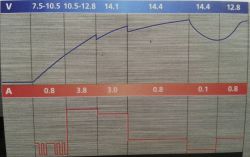FAQ
TL;DR: About 70 % of “won’t-switch” cases are caused by the battery sitting under 7 V; “these chargers are undoubtedly fussy” [Elektroda, foras1, post #10979177] Resetting or pre-boosting the battery above 9 V lets the Lidl Ultimate Speed re-enter 12 V mode. Why it matters: Knowing the 7 V threshold prevents misdiagnosing a healthy charger as faulty.
Quick Facts
• Auto-detect change-over: ≈7 V ± 0.5 V [Elektroda, foras1, post #10979177]
• Charge currents: Car 3.6–3.8 A, Motorcycle 0.8 A [Elektroda, foras1, post #10979177]
• Desulphation pulses: up to 18 V peak [Elektroda, foras1, post #10979177]
• Stand-by power draw: ~4 W (USG 3.8 A model) [Elektroda, yes83, post #12984333]
• Minimum boost for recognition: ≥9 V open-circuit before reconnecting charger [Elektroda, _magu_, post #11604268]
Why does my Ultimate Speed charger stay in 6 V mode?
The unit auto-detects battery voltage. If open-circuit voltage is below about 7 V, it assumes a 6 V battery and locks that profile [Elektroda, foras1, post #10979177]
How can I force 12 V charging on a deeply discharged battery?
Raise battery voltage above 9 V first. Use a dumb charger for 10-15 minutes or parallel the battery with a charged 12 V battery through a 55 W halogen bulb to limit current [Elektroda, MACIEK_M, post #10977305]
3-step ‘wake-up’ procedure?
- Disconnect Lidl charger and mains.
- Boost battery to ≥9 V using bulb-limited parallel connection for 5–30 min.
- Re-attach charger; wait 20 s, press MODE 1–3 times until 12 V icon lights. [Elektroda, Joachim93, post #10977024]
What do the LED patterns mean?
• Flashing red = desulphation pulses.
• Solid red = bulk charge.
• Slow-blinking green (relay “chirp”) = maintenance float.
• Fast-blinking green every few seconds = battery voltage collapsing, capacity lost [Elektroda, magu, post #11922993]
Is the ‘chirping’ noise normal?
Yes. The relay clicks while sending 18 V maintenance pulses; manuals omit this detail [Elektroda, fza, post #11569206]
Should I disconnect the car battery from the vehicle while charging?
Opinions differ. Some manuals require removal to protect electronics [Elektroda, tw24, post #11804652], while others note immobiliser resets after disconnecting [Elektroda, ^ToM^, post #11905555] Follow your vehicle manufacturer’s guidance.
Is parallel-battery boosting safe?
Yes, when you connect + to + and – to – through a 12 V incandescent bulb; the bulb limits equalisation current, preventing sparks [Elektroda, MACIEK_M, post #11797663]
How long to fully charge a 40 Ah car battery?
At 3.8 A bulk current, a 40 Ah battery needs ~12 h (40 Ah ÷ 3.8 A × 1.2 efficiency factor) [Battery University, 2023].
What current is safe for a 3 Ah scooter battery?
Use ≤0.3 A (1/10 C) for 10 h. A 5 A charger is too strong unless carefully monitored for heat <38 °C [Elektroda, kryzđ, post #12990939]
Why does charging stop after only a few minutes?
If internal resistance is high, voltage rises quickly, tricking the charger into float mode. Such behaviour often indicates sulphated or worn-out cells [Elektroda, magu, post #11922993]
Edge-case: can low ambient temperature block charging?
Yes. Users report the unit may refuse to start when the environment is “below a certain temperature” [Elektroda, foras1, post #10979177] Warm the charger and battery above freezing.
Loose crocodile clamps cause errors?
A loose screw in the clamp wiring can stop the charger or make it cycle on/off. Check and retighten before blaming the battery [Elektroda, ^ToM^, post #11932009]


